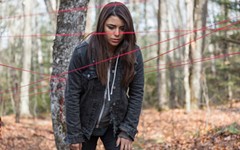DVDanger: Mexico Barbaro
Anthology horror from Mexico
By Richard Whittaker, 11:50AM, Tue. Nov. 10, 2015
Horror cinema and Mexico go together like fangs and bloods. Hint: There's a reason why Universal simultaneously filmed 1931's Dracula in Spanish and English. Yet, for decades it's been tough for American audiences to be exposed to the films. Sample platter Mexico Barbaro aims to rectify that through eight separate stories.
Its timing is perfect: Horror anthologies are the finest proving ground for directors at the moment, letting big names play around, or putting up-and-comers in a bigger project than they could afford. With V/H/S I, II, and III, ABCs of Death and its sequel, the recent Tales of Halloween, and the upcoming Southbound, the genre has scarcely seemed healthier since the glory days of Amicus and Hammer.
The real distinction between them is in format: whether to unlock the stories into freestanding chapters, whether to unify them through concept, or whether to truly interweave them as a single, flowing narrative, a la Trick 'r Treat (arguably the movie that kickstarted the entire Renaissance). Mexico Barbaro is at the furthest extreme of the chapter format.
The English translation (Barbarous Mexico) of the title is a nod to John Kenneth Turner's seminal series of articles on the causes of the Mexican Revolution (itself the inspiration for the 1913 movie of the same name). Laurette Flores Bornn's opener "Tzompantli" looks at the trials and tribulations of modern Mexico, linking the crimes of the cartels to the blood magic of the Aztecs. However, it feels more like a vignette than a fully formed narrative, and it's a little surprising when it turns out not to be a framing mechanism.
By contrast, Edgar Nito's "Jaral de Berrios" is a period piece of horses and repeating rifles with two bandits in the desert. Bar the gruesomeness of the bullet hole one has in his gut, this doesn't immediately seem like horror fodder. But the growing sense that they're not alone in the abandoned church in which they take shelter gives a sense of dusty Gothic. It depends on almost experimental, arthouse cinematography, owing more to Terrence Malick than Wes Craven, and its dreamlike logic opens the door well – both to the film and to Nito as a director.
Moodwise, it's a near perfect fit with "Drena" by Aaron Soto, in which a young girl finds a dead body in a pit under a bridge. It's a slow burn to begin, as slow as the cigarette that she pulls from between the corpses fingers. That defilement may be a hideous mistake, as a supernatural force demands a strange and grisly reparation from her. Again, the emphasis is on arthouse horror, even if its denouement will evoke the visceral cringes of the "Dumplings" segment of Three … Extremes.
That makes Eighties gross-out monster throwback "La Cosa Mas Preciada" a total (and not necessarily welcome) change of pace. Director Isaac Ezban is arguably the most experienced of the contributors to this point, and after the sophomore slump of his Fantastic Fest 2015 feature The Similars (basically an over-extended The Outer Limits tale), audiences may be hoping for a comeback. Unfortunately, he could not restrain his silly, sickly instincts, and the short is weaker for it.
Each part of that opening quartet makes it clear that there is something mystical at play. For "Lo Que Importa es lo de Adentro," Lex Ortega instead channels a small child's fear that the homeless man outside her apartment is really the bogeyman. A seasoned sound designer and veteran short director, with his debut feature Atroz imminent, this gruesome take on what it is that people really have to fear is disturbing and dark.
By contrast, "Dolls" injects another supernatural twist. It's also the film that comes with the most established and credible name attached. Much as Neil Marshall was the biggest "I know that guy" name on the credits for Tales of Halloween, Jorge Michel Grau had his breakout moment with Somos lo Que Hay (later remade as We Are What We Are). Here he eschews the simple narrative of a family in crisis for something far more enigmatic, combining both the slow burn of the opening stories with Ortega's simple, real-life conceit: a woman, hiding from an unseen assailant, walking through a swamp. His black and white nightmare makes overt reference to the notorious Isla de las Muñecas (also known as the Island of Dolls, aka the creepiest place on Earth), and the pay-off is eerie, rather than disturbing.
It's a slice of modern mythology, seguing into the witchcraft of Ulises Guzman's "Siete Veces Siete," in which a scarred caballero undertakes strange magic in the desert. This may be the only segment that becomes a headscratcher due to some lost-in-translation moments (the exact nature of the magic at play, for example), but the simple bones of a man out for revenge in the Highlands are clear enough.
What's fascinating about these segments is that they don't depend on the horror tropes of Catholic angst, border horrors, and cartel brutality that American directors dealing with Mexico tend to fall back upon. Gigi Saul Guerrero sets closer "Día de los Muertos" on the U.S./Mexico border, but only because that's where drunk Yanquis go to patronize La Candelaria, a strip joint where tribute is paid as much to Día de los Muertos as it is to sins of the flesh. The inevitable toll for one ass slap too far won't shock anyone that's seen From Dusk Till Dawn, but the short is a breezy gusto to close out the assemblage.
All in all, Mexico Barbaro is bloody, intriguing fun. It undoubtedly veers into the more visceral end of the blood pool for some segments, but there's nothing that's an outright failure (a rarity in the genre). Instead, it does what anthologies do best: add new filmmaking voices, and scare/gross the crap out of you.
Mexico Barbaro (Dark Sky Films) is available on DVD and VOD now.
A note to readers: Bold and uncensored, The Austin Chronicle has been Austin’s independent news source for over 40 years, expressing the community’s political and environmental concerns and supporting its active cultural scene. Now more than ever, we need your support to continue supplying Austin with independent, free press. If real news is important to you, please consider making a donation of $5, $10 or whatever you can afford, to help keep our journalism on stands.
Richard Whittaker, April 19, 2018
Richard Whittaker, April 3, 2018
Richard Whittaker, July 21, 2018
Richard Whittaker, July 14, 2018
May 31, 2025
DVD Watch, DVDanger, Dark Sky, Mexico Barbaro, Barbarous Mexico













